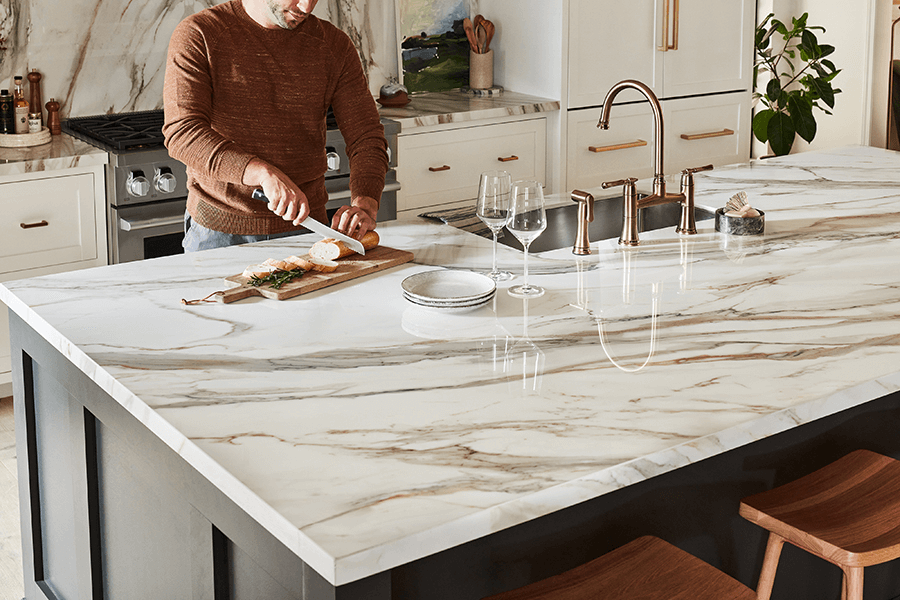Choosing the perfect kitchen countertops involves balancing aesthetic preferences with practical considerations that affect daily life. The right surface improves both cooking efficiency and home value and reflects personal style through material, color, and finish selections. With numerous options available, homeowners need comprehensive information to make informed decisions that satisfy both immediate needs and long-term satisfaction.
Lancaster Kitchens and Baths helps homeowners navigate the complex world of countertop selection through expert guidance and quality installation services. Our kitchen countertop installation expertise ensures that chosen materials are properly installed for maximum durability and performance. Understanding the characteristics of different countertop materials enables confident decision-making that results in beautiful, functional kitchens.
Understanding Your Lifestyle Requirements
Successful countertop selection begins with honest assessment of household cooking patterns and maintenance preferences. Families who cook frequently need durable surfaces that withstand heavy use, while occasional cooks may prioritize aesthetics over extreme durability. Children in the home create different requirements than adult-only households, particularly regarding stain resistance and edge safety.
Maintenance tolerance varies significantly among homeowners. Some people enjoy caring for natural materials that develop character over time, while others prefer low-maintenance surfaces that require minimal attention. Understanding your realistic maintenance commitment prevents disappointment with materials that need more care than you’re willing to provide.
Budget considerations extend beyond initial purchase prices to include installation costs, maintenance requirements, and potential replacement needs. Some materials require professional cleaning, regular sealing, or specialized care products that add ongoing expenses. Calculating total ownership costs over expected lifespans provides better value comparisons than focusing solely on upfront prices.
Natural Stone Options and Characteristics
Granite remains popular for its durability, heat resistance, and unique patterns. Each slab offers distinctive veining and color variations that create one-of-a-kind installations. Properly sealed granite resists stains and scratches while maintaining its appearance for decades. Regular sealing every 1-2 years preserves protection and ensures optimal performance.
Marble provides unmatched elegance and classic appeal but requires more maintenance than granite. Its softer composition makes it susceptible to etching from acidic substances like lemon juice or wine. Marble works beautifully for baking applications due to its cool surface temperature but may not suit households with heavy cooking activities.
Quartzite combines the natural beauty of stone with enhanced durability characteristics. This metamorphic rock offers superior scratch and heat resistance compared to marble while maintaining unique patterns and colors. Quartzite requires periodic sealing but generally needs less maintenance than other natural stones.
Engineered Quartz Surfaces
Engineered quartz combines natural quartz crystals with resin binders to create consistent, durable surfaces. These manufactured materials offer superior stain resistance and require no sealing while maintaining consistent patterns and colors. The non-porous surface prevents bacterial growth, making quartz ideal for food preparation areas.
Color and pattern consistency appeals to homeowners seeking uniform appearances throughout their kitchens. Engineered quartz eliminates the natural variations found in stone, creating predictable results that match design expectations. This consistency simplifies design planning while ensuring replacement pieces match existing installations.
Heat resistance limitations require caution with hot cookware. While quartz handles normal cooking temperatures, direct contact with extremely hot pans can damage the resin binders. Using trivets and hot pads protects surfaces while maintaining warranties and preventing costly repairs.
Solid Surface Materials
Solid surface materials like Corian provide seamless installations with integrated sinks and backsplashes. These synthetic materials offer repairable surfaces that can be restored to original condition if damaged. Scratches and minor damage can be sanded out, making solid surfaces ideal for high-use kitchens.
Design flexibility allows curved edges, integrated features, and custom shapes that natural materials cannot achieve. Solid surfaces can be thermoformed into complex configurations that create unique design elements. This versatility appeals to homeowners seeking distinctive installations that showcase creative design solutions.
Color options range from solid hues to patterns that mimic natural materials. Solid surfaces accept stains and dyes for custom color matching, enabling perfect coordination with existing design elements. The ability to create custom colors ensures design continuity throughout kitchen spaces.
Butcher Block and Wood Countertops
Wood countertops bring warmth and natural beauty to kitchen environments. Different wood species offer varying colors, grain patterns, and durability characteristics. Hard woods like maple and oak provide excellent durability, while softer woods like pine require more careful maintenance to prevent damage.
Maintenance requirements include regular oiling to prevent drying and cracking. Food-safe oils like mineral oil or specialized wood conditioners protect surfaces while maintaining food safety. Wood countertops can be sanded and refinished multiple times, extending their lifespan significantly beyond other materials.
Antimicrobial properties of certain wood species provide natural protection against bacteria. Studies show that wood surfaces can actually inhibit bacterial growth better than some synthetic materials. This natural antimicrobial action makes wood countertops safe for food preparation when properly maintained.
Stainless Steel Professional Surfaces
Stainless steel countertops offer professional-grade performance with superior heat and stain resistance. These surfaces handle hot cookware without damage while providing hygienic food preparation areas. Stainless steel’s non-porous surface prevents bacterial growth and cleans easily with standard household cleaners.
Durability characteristics include resistance to scratches, stains, and heat damage. While stainless steel can show fingerprints and water spots, these marks don’t affect performance and clean away easily. The material’s strength allows thin installations that maximize storage space beneath countertops.
Design integration works particularly well with contemporary and industrial-style kitchens. Stainless steel coordinates naturally with professional-grade appliances while creating cohesive design themes. Custom fabrication allows integration of sinks, drain boards, and other features for seamless installations.
Tile and Ceramic Surfaces
Ceramic tile countertops offer extensive design flexibility at budget-friendly prices. Tiles come in countless colors, patterns, and textures that enable creative installations. Large-format tiles minimize grout lines, while smaller tiles create intricate patterns and artistic designs.
Grout maintenance represents the primary challenge with tile countertops. Regular cleaning and periodic sealing keep grout lines attractive and hygienic. Epoxy grouts offer superior stain resistance but require professional installation. Proper grout selection and maintenance determine long-term satisfaction with tile surfaces.
Heat resistance makes tile suitable for areas around cooktops and ovens. Most ceramic tiles handle hot cookware without damage, though thermal shock from extreme temperature changes can cause cracking. Using trivets near cooking areas prevents potential damage while maintaining surface integrity.
Concrete Countertop Possibilities
Concrete countertops enable complete customization in terms of color, texture, and integrated features. Pigments, aggregates, and finishing techniques create unique surfaces that express personal style. Concrete can incorporate decorative elements like glass chips, stones, or metal accents for distinctive appearances.
Durability depends heavily on proper mixing, installation, and finishing techniques. Well-executed concrete countertops provide excellent performance for decades, while poor installation creates problems like cracking or staining. Professional installation ensures proper techniques and long-term satisfaction.
Maintenance requirements include regular sealing to prevent stains and water damage. Different sealers offer varying levels of protection and appearance characteristics. Some sealers enhance concrete’s natural appearance, while others provide glossy finishes that change the material’s character.
Laminate and Budget-Friendly Options
Modern laminate surfaces offer improved durability and appearance compared to older generations. High-pressure laminates resist scratches and stains while providing realistic wood and stone appearances. These surfaces provide attractive options for budget-conscious homeowners without sacrificing style.
Installation advantages include lighter weight and easier handling compared to stone materials. Laminate countertops can often be installed over existing surfaces, reducing renovation costs and timeline. DIY installation remains possible for skilled homeowners, though professional installation ensures optimal results.
Limitations include susceptibility to damage from heat and sharp objects. While modern laminates offer improved performance, they cannot match the durability of stone or solid surface materials. Understanding these limitations helps set appropriate expectations for laminate installations.
Edge Profiles and Finishing Options
Edge profiles significantly impact both appearance and functionality. Simple eased edges provide clean, contemporary looks while offering safety benefits. Ogee and other decorative edges create traditional appearances but require more maintenance around detailed areas.
Functionality considerations include ease of cleaning and safety for household members. Rounded edges clean more easily than sharp corners while providing better safety for children. The edge profile should complement the overall design style while meeting practical requirements.
Cost implications vary based on edge complexity and material type. Simple edges cost less to fabricate and install, while complex profiles require additional time and expertise. Balancing aesthetic preferences with budget constraints helps determine appropriate edge selections.
Color and Pattern Coordination
Kitchen countertops in Lancaster PA showcase the importance of selecting materials that balance style with functionality. Professional installation and quality materials create surfaces that serve households effectively for decades.
Color selection affects both immediate visual impact and long-term satisfaction. Neutral colors offer timeless appeal and flexibility for future design changes. Bold colors create dramatic statements but may limit future design options. Consider how countertop colors will coordinate with existing and planned design elements.
Pattern scale influences visual perception of space size. Large patterns can overwhelm small kitchens, tiny patterns may disappear in large spaces. Consistent patterns provide uniform appearances, varied patterns create visual interest and hide minor imperfections.
How to pick the perfect kitchen countertop involves balancing multiple factors including durability, maintenance requirements, and aesthetic preferences. This comprehensive selection process prevents costly mistakes and provides long-term satisfaction with your investment.
Lighting interactions affect color appearance throughout the day. Natural light reveals true colors, while artificial lighting can shift color perception. Test countertop samples under different lighting conditions to ensure satisfaction with color choices in your specific environment.
Installation Considerations and Timeline
Professional installation ensures optimal performance and warranty compliance. Skilled installers understand material-specific requirements and potential challenges. Proper installation prevents problems like cracking, staining, or premature wear that can result from inexperienced installation.
Timeline planning should account for material lead times and installation scheduling. Natural stone requires templating visits after cabinet installation, while prefabricated materials may install more quickly. Custom fabrication adds time but enables perfect fits and unique features.
Preparation requirements vary by material type. Some surfaces require reinforced cabinet structures, while others install over standard construction. Understanding preparation needs helps plan renovation timelines and budgets accurately.
Making Your Final Decision
Comparing samples in your actual kitchen environment provides the most accurate assessment of how materials will look and perform. Take samples home and observe them under different lighting conditions throughout the day. This evaluation process prevents costly mistakes and ensures satisfaction with final selections.
Professional consultation helps navigate complex decisions while ensuring optimal results. Experienced designers understand how different materials perform in various applications. Their expertise helps balance aesthetic preferences with practical requirements for successful installations.
Ready to explore countertop options for your kitchen renovation? Contact Lancaster Kitchens and Baths today to schedule a consultation and begin planning your perfect countertop installation.
Industry Resources and Standards
The Natural Stone Institute provides comprehensive information about natural stone care, maintenance, and selection guidelines. Their resources help homeowners understand the characteristics and requirements of different stone materials for informed decision-making.
The Kitchen Cabinet Manufacturers Association offers guidelines for cabinet construction and countertop support requirements. Their standards ensure that cabinet structures can properly support different countertop materials while maintaining structural integrity and warranty compliance.
Frequently Asked Questions
What’s the most durable countertop material for busy kitchens?
Engineered quartz and granite offer excellent durability for high-use kitchens. Quartz provides superior stain resistance and requires no sealing, while granite offers heat resistance and unique natural patterns. Both materials handle heavy use well when properly installed and maintained. Consider your specific cooking habits and maintenance preferences when choosing between these durable options.
How much do different countertop materials typically cost?
Countertop costs vary significantly based on material, complexity, and installation requirements. Laminate ranges from $20-50 per square foot installed, while granite and quartz typically cost $60-120 per square foot. Exotic materials like marble or quartzite can exceed $150 per square foot. Always request detailed quotes that include materials, fabrication, and installation for accurate cost comparisons.
Do I need to seal my countertops?
Natural stone materials like granite and marble require periodic sealing to prevent stains and water damage. Engineered quartz and solid surface materials don’t require sealing. Wood countertops need regular oiling rather than sealing. The sealing frequency depends on usage patterns and stone porosity, typically ranging from annually to every 2-3 years.
Can I install countertops myself?
Some materials like laminate and tile can be DIY-installed with proper tools and skills. Natural stone and engineered quartz require professional installation due to weight, specialized tools, and precision requirements. Improper installation can void warranties and create safety hazards. Consider your skill level and available time when deciding between DIY and professional installation.
Which countertop materials work best with undermount sinks?
Solid materials like granite, quartz, and solid surface work excellently with undermount sinks. These materials provide strong, sealed edges that prevent water infiltration. Tile countertops can accommodate undermount sinks with proper waterproofing. Laminate typically requires drop-in sinks due to edge construction limitations. Consider sink style preferences when selecting countertop materials.





